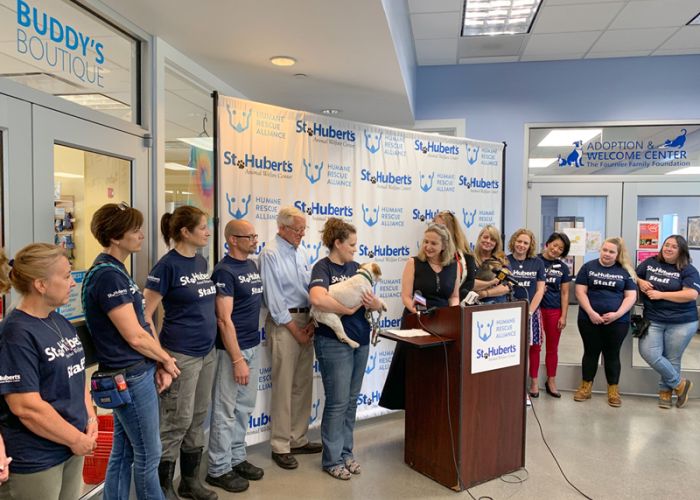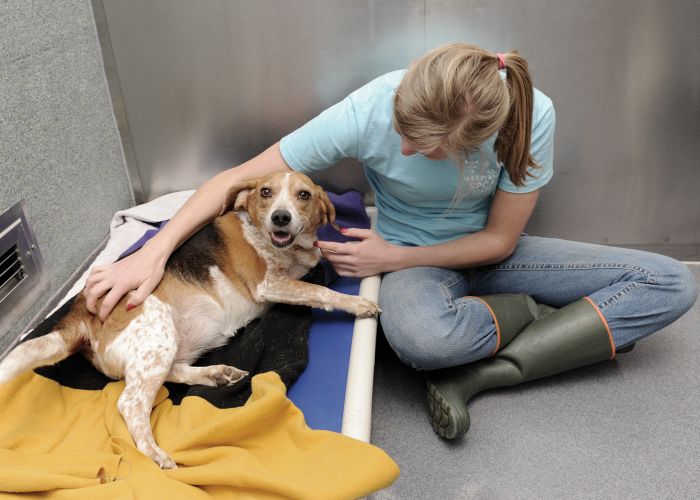The pursuit of employee happiness
When shelters make employee morale a priority, everyone benefits

You know how it happens. One dog comes into your shelter—maybe she’s stressed or scared and starts barking. She won’t stop, and now it’s escalating. Another dog starts barking, then another, and before you know it, you have a chorus of barking dogs echoing throughout the building.
The ripple effect of emotions isn’t limited to the animals in your shelter. If you’re not focusing enough on the well-being of your staff, who are rewarded but also brought down by the daily toils of shelter work, before you know it, you can have a work environment full of negativity and under-appreciated employees, or low morale.
It’s true that shelters often have limited resources. They aren’t Google and can’t shower their employees with perks like unlimited food, nap pods and free massages.
The good news is that you don’t necessarily need a lot of money to improve employee morale. If shelters make employee morale a priority, there are ways to ensure the employees are just as happy and healthy as they strive for the animals in their care to be.
Morale problems on steroids
To improve morale, shelter directors first need to recognize that people are an important resource and worthy of investment, which doesn’t happen enough at shelters, says Steven Rogelberg, a professor at the University of North Carolina at Charlotte who specializes in employee engagement and well-being.
Rogelberg works on the Shelter Employee Engagement & Development Survey (SeeDS), an initiative The HSUS supports that helps shelters improve employee engagement.
The fact is, “the people, animals and success of the organization are all completely connected,” he says. “And too many executive directors think that it’s just about the animals at the organization, and it’s not. The people are the absolute fuel, and if they are not in a healthy state, it will not only undermine the organization’s ability to fulfill its mission [but it] takes a negative toll on the animals.”
The main factors that drive morale (your supervisor, peers, the work itself, communications, opportunities to advance and cross-departmental relationships) aren’t different in shelters than any other workplace, but what’s unique in shelters is the high stress coupled with passion, he says. In his work, he sees that shelters have higher employee burnout than private-sector jobs.
“The stress levels serve as a steroid of sorts,” he says, “so that the types of things that are problematic in shelters just take on increasing burden given the high stress. So if you don’t have good communication, you don’t have a good boss, you don’t have good coordination across departments and high stress, those things really just take a toll on you.”
Plus, the passion that people bring to their work can be a great thing, but it can also “make the experiences more frustrating and more upsetting,” he says.

Raising their voice
Before you start having a party every time an animal gets adopted, rewarding employees for simply showing up to work or communicating every decision down to your daily lunch choice with employees, you should find out what’s driving down employee morale so you can know what you’re trying to fix.
Showing employees you appreciate them through celebrations or recognition programs can boost morale in some cases, especially if you can’t give out other perks like salary increases, but parties aren’t the key if morale is low because of other problems, like poor communication and poor leadership.
To identify what the problem areas are, any shelter that wants to fix morale should have employees take a survey, like SeeDS, says Rogelberg.
Surveying employees can help create a healthy environment because employees feel they have a voice, and people “really desire so strongly to be able to have a voice in things that have an effect on them,” he says.
The SeeDS survey takes less than 10 minutes to complete and asks questions about roughly 12 topics that tie into employee engagement. The answers are analyzed to find trends and areas where shelters fall short—most score low on communication and cross-departmental relationships, says Rogelberg.
Talking to employees individually and in groups is also helpful, but doing an anonymous survey like SeeDS creates a “safe space,” he says.
Once you know how the employees feel, you can act. Rogelberg is an advocate of assembling cross-departmental teams to brainstorm improvements. For example, the group could come up with 10 ideas for improving communication or coordination across departments.
“They can do it in a flash because there’s low-hanging fruit,” he says. “I’m a big believer in trying to leverage organic approaches that allow ideas to emerge upward.”
Kudos culture
At PAWS in Washington state, whether employees are stressed because the organization is understaffed or dealing with kitten season, a “kudos culture” helps staff see situations in a positive light, improves communication, builds cross-departmental relationships and recognizes hard-working employees.
When staff morale is down, people gossip, become negative and don’t recognize when a colleague has done really good work, says Kay Joubert, director of companion animal services.
That’s where the kudos come in. When staff complain or say something negative, they have to write two “kudos cards” or put change in a “complaint jar,” but most people choose to write kudos. Kudos cards are simple—staff write compliments to one another on slips of paper that say “Kudos.” Joubert says she’ll gently remind her employees to write kudos cards if she hears them complaining, but staff largely enforce it among themselves.
When staff members get 15 kudos cards, they have a chance to be picked as “Employee of the Month” and win an inexpensive or donated prize. Past prizes have included a book or a gift basket with a couple of movies, candy and popcorn. If more than one employee has 15 cards at the end of the month, the winner is selected randomly.
It took a while for people to warm to the program, which was implemented a few years ago, but now they’re really invested in it, says Joubert.
“Some people [would] embrace it in a funny way,” she says. “[They would say] ‘I’m going to still get my grump out,’ and then they’d write up a bunch of kudos cards … and it would make them laugh. It would make them realize that it’s OK to have a moment when you’re just upset about something or worried about something or just feel like you need to take a moment to vent. But then it helps people turn that around and lets them kind of lift the spirit back up.”
It also helps managers realize when there is a problem that needs to be fixed or people are really struggling, she says.
By thinking about what they’re saying and focusing on the positives, staff have realized they don’t need to complain, because they can come to managers who will hear them out if they really have a problem.
This system has also improved cross-departmental relationships.
“If your agency is a little bit compartmentalized … the nice part is it helps people to see what others are doing and encourages them to start noticing those things and writing cards to folks they don’t necessarily work as closely with,” like your IT person or your office manager, Joubert says. “It does really improve … communication, which is the key to just about everything.”
A positive attitude
At Second Chance Animal Shelter in Massachusetts, executive director Sheryl Blancato also tries to focus on the positives and compares it to people who will give a meal a bad review online but not leave a review about a great meal.
“What we’re trying to do is kind of change that culture a little bit and say … if you have a great meal, celebrate it,” she says. “And the same thing in animal welfare. Celebrate the animals you’re saving.”
Staff at each of its three facilities send in a blurb about one positive thing that happened there every week, and the communications department shares them on Facebook; the staff sees all the stories, so “they’re always reminded over and over that this is why we’re here,” says Blancato.
Managers also try to keep an eye on staff and recognize if anyone is having problems.
“You cannot replace a one-on-one conversation with an employee,” says Edward Yost, a human resources business partner at the Society for Human Resource Management. In shelters with few employees, it can be easier for managers to recognize when people are having problems and find solutions. Morale problems can be very personal, and the same solution may not work for everyone, he says.
“They may need a break, whatever that looks like,” he says. They may just need “something to change up the day-to-day to re-energize them.”
Second Chance has regular staff meetings so people can vent and create solutions for problems, like when staff at the different facilities weren’t getting along or feeling valued by their peers. Management learned each facility’s schedule and the best time to contact staff there (not during the busy surgery check-in time at the clinic), the best method of contacting them and who to call for what to “avoid wasting time and aggravating an already busy staff,” says Blancato.
A business psychologist also volunteered to speak to the individual departments and work through their problems. Eventually, everyone felt like they were being listened to, and it helped them work together, “understanding they all had the best interest of the pets at heart,” says Blancato.
A SeeDS recommendation for building cross-departmental relationships is to have employees rotate through different departments, doing different jobs to learn about each person’s role.
Rotating through different departments can also ensure that “everybody has an opportunity to see the adoptions, to see the happy-endings piece of what it is they’re doing and get a better understanding of how they’re contributing to those good outcomes,” says Yost.

The joy of learning
Training is another great way to boost morale. It not only helps people do their jobs better but it “demonstrates to people that you’re investing in them,” says Bonney Brown, former executive director of Nevada Humane Society (NHS) and founder of Humane Network, a nonprofit consulting group for shelters.
When she worked at NHS, Brown developed a training budget for staff to go to conferences like The HSUS’s Animal Care Expo. Many donors got involved in sponsoring trainings, she says.
First-time supervisors would get training, because in shelters, the person who gets promoted is often the one who is best at cleaning kennels, which doesn’t always translate to managerial skills, says Brown.
Brown recommends supervisor trainings offered through SkillPath (skillpath.com), National Seminars Group (nationalseminarstraining.com) or Fred Pryor (pryor.com), which she says all provide quality one- or two-day trainings across the U.S. They are generally inexpensive (some are under $100), and some offer group discounts.
Even online trainings can be helpful. ASPCA Pro (aspcapro.org/recorded-webinars.php), animalsheltering.org/trainings and Maddie’s Institute (maddiesfund.org/maddies-institute.htm) offer a variety of webinars and free trainings.
Brown’s shelter also hosted speakers about various topics, from customer service to working with shy cats to animal behavior and body language. She held these trainings multiple times during the day so the staff could rotate through depending on their shifts and duties.
You can also let your employees be teachers instead of students, says Yost. Arrange for employees to go to local businesses and make presentations about the work your shelter is doing. It gives employees something to do outside of their normal routine and possibly gets the shelter more donors and volunteers.
And as the employee, “you get to feel better about what you’re doing because you get to talk about what you’re doing, you get to share it with somebody else,” says Yost.
Everyone loves free food
When Brown worked at NHS, one of the biggest staff morale-boosters was having the managers serve staff a meal, like a pancake breakfast.
This would happen a couple of times a year, usually after the shelter reached an adoption goal, and managers or Brown would foot the bill.
“It doesn’t have to cost a ton of money to make a great impression on the staff,” she says.
NHS also had departments compete against each other in a holiday tree-decorating contest that everyone really got into, says Brown. In addition, workers nominated each other for monthly employee recognition awards, with prizes that included a good parking spot for a month.
“I’m always shocked when I talk to organizations that don’t have any kind of a party, either for the holidays or really for anything,” says Brown. “Even if it’s a potluck kind of thing, it really does help.”
At Second Chance Animal Shelter, managers will provide lunch or snacks for staff on busy or taxing days—say, pizza when the spay/neuter clinic has a much larger turnout than expected.
Managers sometimes pay out of pocket, but the shelter also has relationships with local stores that donate gift cards to the shelter and sometimes honor them for more than they’re worth, says Blancato.
Shelter directors could also negotiate discounts for their employees at local businesses, like movie theaters or bowling alleys, and in return the shelter could offer employees at partner businesses discounts on fees if they adopt from the shelter, says Yost.
“It takes some legwork,” but it’s worth it, he says.
At PAWS, each employee receives a card signed by their whole department for their work anniversary and birthday, with gift cards of $10 and $5, respectively. Joubert acknowledges that if organizations can’t spare that money, just a card is a nice gesture.
“I think it really does help people to feel acknowledged and just appreciated, and it recognizes them as a member of the team at least two other times during the year,” she says.
Handwritten cards from managers thanking their employees can be especially beneficial, says Yost. Taking the time to pick out a card and write it (as opposed to sending an email) implies sincerity and a greater level of appreciation, he says.
“What it comes down to is: It doesn’t have to be big and flashy and expensive when it comes to helping your employees to feel valued,” he says.
And when your employees feel valued and energized, the animals can only benefit.







